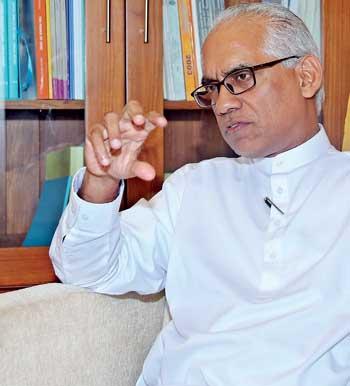12 Nov 2019 - {{hitsCtrl.values.hits}}

State Minister of Finance, Eran Wickramaratne, one of the members of the team which penned the manifesto of New Democratic Alliance’s Presidential candidate Sajith Premadasa, says that the UNF manifesto is not a set of promises, but a pledge for the people. Minister Wickramaratne complained that the financial figures presented in Gotabaya Rajapaksa’s manifesto are beyond reality.
Following are excerpts of an interview done with Wickramaratne.
 Q We come across manifestos during all elections and is this another set of promises which is beyond reality? What does this manifesto stand for?
Q We come across manifestos during all elections and is this another set of promises which is beyond reality? What does this manifesto stand for?
What you said is correct in a way. Historically manifestos contain a lot of promises. But we tried hard to make sure that this is a policy document with some specific proposals. We want to make sure what we put down in writing we actually will implement. So we drafted it carefully. When Sajith Premadasa decided to unveil his manifesto, he took it to the historical city of Kandy and to the Maligawa. The significance of that was that it was not a promise, but more of a pledge as opposed to a promise. This was done to show his commitment to implement what is written in the document.
Q There is criticism by experts that there is incompatibility between the socio-political policies and economic policies. How do you explain this?
In economics, there are competing interests. That is the nature of economics. You can use what’s incompatible but it is competing interests. Certainly, even in our manifesto it is there. On one hand we want to develop the economy and therefore we have to incentivise those who could actually grow the economy. And then the manifesto is made on three pillars and the first pillar is creating strong state, the second is to create a competitive market and the third pillar is to create a fair and just society. So if you take the competitive market and the competitive economy and you contrast it with social justice and fair society, what you said could be seen like that. But you need both and the question is where would you draw the line to balance the issue.
Q But the biggest issue is where do you find the money? Because there are so many concessions and allowances to both private and public sector.
 So actually I have done that exercise by doing a costing. I have taken Sajith’s manifesto and we have said for example that NDT and VAT taxes should be together. And we have said that we will decrease VAT. We have said that we will face off para tariffs over the period of five years. We have said that we will reduce mobile broadband charges and we also said that we will increase the VAT threshold per month from one million to four million and Rs.12 million to Rs. 50 million per annum, which means small companies will not have to pay it. We will remove the carbon tax and if these costs are reduced, it comes to about Rs. 178 billion. We have done a costing because we want to make sure that our policies are as close as possible to reality in its implementation. Then there are other little things like future taxes. These will be foregoing present taxes. If you look at future taxes, we are doing NRFC withholding tax reduction and we are going to reduce effective taxes on tech companies to five per cent. We are going to reduce dividend taxes on tech companies producing intellectual property. We are going to reduce taxes on electric automotive batteries to promote green energies. We are also going to slash taxes on agricultural machineries and machine parts. We have plans to introduce taxes to minimise the post-harvest losses. We’ll also reduce taxes on animal feed to support high yield dairy farms.
So actually I have done that exercise by doing a costing. I have taken Sajith’s manifesto and we have said for example that NDT and VAT taxes should be together. And we have said that we will decrease VAT. We have said that we will face off para tariffs over the period of five years. We have said that we will reduce mobile broadband charges and we also said that we will increase the VAT threshold per month from one million to four million and Rs.12 million to Rs. 50 million per annum, which means small companies will not have to pay it. We will remove the carbon tax and if these costs are reduced, it comes to about Rs. 178 billion. We have done a costing because we want to make sure that our policies are as close as possible to reality in its implementation. Then there are other little things like future taxes. These will be foregoing present taxes. If you look at future taxes, we are doing NRFC withholding tax reduction and we are going to reduce effective taxes on tech companies to five per cent. We are going to reduce dividend taxes on tech companies producing intellectual property. We are going to reduce taxes on electric automotive batteries to promote green energies. We are also going to slash taxes on agricultural machineries and machine parts. We have plans to introduce taxes to minimise the post-harvest losses. We’ll also reduce taxes on animal feed to support high yield dairy farms.
Q So with all these tax reductions and tax slashes how are you going to finance the economy?
We are going on a policy on alcohol and tobacco. But it will not be an arbitrary policy like other people have done. We are going for an indexation policy and raise money over a period of time. The other thing we are doing is, we have a newly introduced Inland Revenue Act which is really a progressive move because the government policy is stated there clearly. The discretion of the Minister has been removed. The tax base will be widened. The number of people paying tax will be widened. That is going to be really factful and it will help social justice. The other thing is better use of technology, digital integration of government entities and ect. If you add those numbers as much as Rs 178 billion can be raised through that process. We have been very careful in what we have said and we are trying to do it very responsibly.
On the other hand if you take Mr. Rajapaksa’s taxes, he said he will abolish payee tax, he will abolish economic service charge, withholding tax, slash VAT from 15 to eight, bring down corporate tax from 28 to 18 and abolish NBT and reductions in service charges of telephone and the internet by 50 percent. Actually there is no credibility in what he says. According to 2019 figures, if you abolish paye you are talking about Rs. 65 billion. If you take ESE Rs. 65 billion. If you take withholding tax it is about 52 billion, if you are halving VAT, the loss is about Rs. 247 billion, if you reduce corporate tax 28 per cent to 18, it is about Rs.96 billion loss. Reduction of NBT is about 91 billion. So if you look at the total it comes to like Rs. 630 billion. So it is totally unviable and totally unrealistic. I don’t think Gotabaya Rajapaksa himself had worked these numbers because his expertise is in a different area. But I certainly hold Gotabaya’s advisers responsible for actually misleading their candidate with really non-credible or incredible numbers. So that tax revenue loss is like 30 per cent of the 2019 numbers. And the tax loss is about 4.4 per cent of GDP. If you actually do these revenue losses the Budget deficit which was 5.4 percent in 2018 will rise to about 9 percent of GDP.
QYou being the State Minister of Finance, what is your response to severe criticism against Millennium Challenge Corporation (MCC) agreement?
If the Cabinet has not approved the MCC grant, Sri Lanka would have lost USD 480 million which is equivalent to Rs. 85 billion. This is because MCC grant is given to low-income countries or middle-income countries in lower category. And Sri Lanka was in that category. In 1997 we graduated from being a low-income country to low middle-income country. In July 2019 we graduated from a low middle-income country to a higher middle-income country. When MCC in December publishes eligible countries for 2020, Sri Lanka will not be eligible. Since we are currently eligible, the Sri Lankan cabinet took the responsibility with regard to the risk posed by others misrepresenting facts and approved it thinking of the country rather than most immediate political disadvantages. But our government has no intention of doing anything secretly. Therefore now that we have shown our serious interest in it, it will be taken to parliament and the agreement is available for public discussion. And parliament has to approve this and only when parliament approves it that the project will begin. So there is no hidden agenda here. It is a huge benefit to the country. But facts are being misrepresented. There are huge components in that; one is removing urban congestion, manging the road system, managing junctions electronically, passengers having information in their apps, managing the public road system, improving security in public transport which is a huge advantage for women in this country. MCC projects have been commenced in 34 countries in the world already.
10 Jan 2025 49 minute ago
10 Jan 2025 1 hours ago
10 Jan 2025 1 hours ago
10 Jan 2025 3 hours ago
10 Jan 2025 3 hours ago